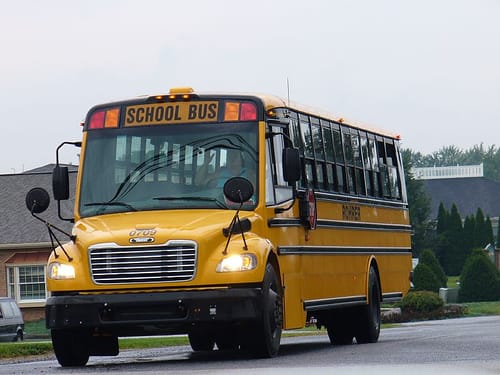
Dressed for Success? The Effect of School Uniforms on Student Achievement and Behavior
It's what's on the inside that counts

It's what's on the inside that counts










School-uniform policies have become prevalent since the mid-1990s, with almost 20 percent of public schools requiring them as of 2007-08. From Long Beach, CA to Boston, MA, urban districts cite intrinsic benefits of these equitable outfits: They contribute to school order and safety and decrease social stratification. But these benefits are all anecdotal—uniform policies have largely evaded robust quantitative analysis. This National Bureau of Economic Research (NBER) paper seeks to fill the gap. NBER analysts parsed data from a large urban school district in the southwest (administrative records from 1993-2006 and test data from 1998-2006 were used). Their findings: At the elementary level, uniforms were positively correlated with teacher retention (attrition went down 5 percent with the adoption of uniform policies). At the secondary level, they showed a slightly positive impact on student attendance (more so for girls than boys, and more so for economically disadvantaged students at high-poverty schools). But on student achievement, disciplinary infractions, and grade retention, uniforms had no discernable effect. Which probably shouldn’t be too surprising; as they always say, it’s what’s on the inside that counts.
Elisabetta Gentile and Scott A. Imberman, Dressed for Success? “The Effect of School Uniforms on Student Achievement and Behavior,” (National Bureau of Economic Research Working Paper, August 2011).

This International Association for K-12 Online Learning (iNACOL) report proposes a state-policy framework for performance-based learning, which would allow students to advance from grade-to-grade and course-to-course based on subject mastery as opposed to seat time. (At present, performance-based learning is predominantly delivered through digital and blended approaches.) The report’s policy proposals are sound, if somewhat obvious. But that’s not all this publication offers. For one, it serves up in-depth case studies of a handful of exemplar states, including Alabama, New Hampshire, and Oregon—articulating the positive elements of these states’ policies and where they could still be improved. Second, Susan Patrick, the report’s author and iNACOL’s president, troubleshoots potential hiccups in implementing performance-based learning, framing six emerging challenges and offering specific state-policy design elements addressing each. For example, one potential concern with performance-based learning is how to create a student-centered accountability model. In order to do so, she argues, states should move from once-annually testing regimes to more frequent modularized testing. Anyone who thinks digital learning is poised to play a big role in our K-12 system going forward (and that should mean all of you!) ought to give this piece of work a look.
Susan Patrick, “Cracking the Code: Synchronizing Policy and Practice for Performance-Based Learning,” (Vienna, VA: International Association for K-12 Online Learning, July 2011).

There are dichotomous views of teachers permeating today’s education-policy conversation, according to this documentary from the folks at the Teacher Salary Project, an NPO dedicated to “improving working conditions” of American public-school teachers. On one end, the “teaching profession has never been less respected.” (Of course, after reading the latest PDK/Gallup poll, one could argue that this isn’t the case.) On the other, it is widely recognized that educators are the single most important in-school factor for raising student achievement. To show how important teachers are, and how undervalued they feel, this film follows three teachers and one former teacher for two years—and offers interview snippets from many more. Each of the featured educators is dedicated; each is well-regarded by students and parents. Yet each feels that teachers are underpaid and, thus, undervalued. (One quit the profession for a more lucrative career, another works two jobs in addition to teaching, yet still had his house foreclosed.) The stories of these teachers—and those like them—are powerful and worth telling. Effective, dedicated teachers absolutely should be paid more than most make today. But the film—to its detriment—skirts around discussing how to manage (or counsel out) less effective teachers. It praises D.C.’s IMPACT system for its ability to identify and reward top performers, but fails to explain the implications of IMPACT for those in the bottom quartile. The same goes for its treatment of Denver’s PROCOMP program. Again, stellar teachers should be rewarded and respected. But a conversation about professionalizing teaching without a discussion of variant teacher ability is no conversation at all. (PS, as you’re watching, listen to the familiar voice of the narrator—it’s Matt Damon.)
Vanessa Roth, dir. American Teacher, (Teacher Salary Project, 2011).



Sans union, Duffy sings a different tune
(Photo by Horia Varlan)
Last week, former UTLA president A.J. Duffy dropped jaws, froze Hell, and launched squealing swine high into the sky when he announced the creation of his very own charter school, Apple Academy Charter Public School. The move turned heads for a few reasons, the least of which was that Duffy vehemently crusaded against charter-school growth as UTLA president. Furthermore, at Apple Academy, teachers (who will be unionized) will not be tenured, at least in the traditional sense of the word. (Teachers with positive performance reviews will receive a degree of greater job security, but it won’t be granted for life.) Further, teachers who are “tenured” at Apple Academy can still be fired—with “due-process” dismissals taking ten days (instead of the seemingly requisite three years they take now). The move has left even the most foresighted education pundits guessing as to why. But here’s Gadfly’s speculation: As head honcho and mouthpiece of UTLA, Duffy was forced to speak for the collective voice of union members—which meant speaking to protect the worst among them. With UTLA’s bullhorn retired, Duffy is free to articulate, and act on, his own opinions—no matter how inflammatory they are to his ex-union cronies. The lesson for reformers: As Mike Antonucci has implored forever, we’re naïve to think of union leaders as independent actors, when in fact they are simply politicians who must please their base. We ignore the internal political dynamics of unions at our peril.
| Click to listen to commentary on Duffy's charter school from the Education Gadfly Show podcast |
|
“At his charter school, ex-UTLA head would target tenure,” by Howard Blume, Los Angeles Times, September 1, 2011. |


We're for choice, but busing goes too far?
(Photo by Kevin)
In the 1970s, after seeing an exodus of white families to the suburbs, Detroit leaders attempted to instate a forced-integration busing policy, transporting black inner city youth to largely white suburban schools—and vice versa. The intended policy shift quickly made its way to the courts, finally landing with the U.S. Supreme Court. In the High Court’s 5-4 Milliken v. Bradley decision, justices ruled against the Detroit busing strategy. Thirty-seven years later, Wolverine State governor Rick Snyder has proposed a new escape valve for Detroit children trapped in lousy, and segregated, public schools: He would mandate open-enrollment school choice, in effect making district boundaries obsolete. In a scathing op-ed in the Detroit News, former Wayne County chief of staff Bill Johnson, called on Snyder to arrest his “social-engineering experiment,” arguing that the residents of Wayne County (an affluent area to which many Motown children are likely to flee) shouldn’t be responsible for “inner city students who are apt to bring a lot of baggage and few socialization skills to suburban school environments.” Ugly words—though Johnson is probably just giving voice to the (quasi-racist) sentiments of many of his fellow suburbanites (and not just in Michigan). So conservatives: Are we in favor of giving kids options, or not?
|
“Conservatives erect a wall against a conservation governor,” by Adam Emerson, ReDefinED, September 7, 2011. “Choose local school choice,” by Bill Johnson, Detroit News, September 7, 2011. |


School-uniform policies have become prevalent since the mid-1990s, with almost 20 percent of public schools requiring them as of 2007-08. From Long Beach, CA to Boston, MA, urban districts cite intrinsic benefits of these equitable outfits: They contribute to school order and safety and decrease social stratification. But these benefits are all anecdotal—uniform policies have largely evaded robust quantitative analysis. This National Bureau of Economic Research (NBER) paper seeks to fill the gap. NBER analysts parsed data from a large urban school district in the southwest (administrative records from 1993-2006 and test data from 1998-2006 were used). Their findings: At the elementary level, uniforms were positively correlated with teacher retention (attrition went down 5 percent with the adoption of uniform policies). At the secondary level, they showed a slightly positive impact on student attendance (more so for girls than boys, and more so for economically disadvantaged students at high-poverty schools). But on student achievement, disciplinary infractions, and grade retention, uniforms had no discernable effect. Which probably shouldn’t be too surprising; as they always say, it’s what’s on the inside that counts.
Elisabetta Gentile and Scott A. Imberman, Dressed for Success? “The Effect of School Uniforms on Student Achievement and Behavior,” (National Bureau of Economic Research Working Paper, August 2011).

This International Association for K-12 Online Learning (iNACOL) report proposes a state-policy framework for performance-based learning, which would allow students to advance from grade-to-grade and course-to-course based on subject mastery as opposed to seat time. (At present, performance-based learning is predominantly delivered through digital and blended approaches.) The report’s policy proposals are sound, if somewhat obvious. But that’s not all this publication offers. For one, it serves up in-depth case studies of a handful of exemplar states, including Alabama, New Hampshire, and Oregon—articulating the positive elements of these states’ policies and where they could still be improved. Second, Susan Patrick, the report’s author and iNACOL’s president, troubleshoots potential hiccups in implementing performance-based learning, framing six emerging challenges and offering specific state-policy design elements addressing each. For example, one potential concern with performance-based learning is how to create a student-centered accountability model. In order to do so, she argues, states should move from once-annually testing regimes to more frequent modularized testing. Anyone who thinks digital learning is poised to play a big role in our K-12 system going forward (and that should mean all of you!) ought to give this piece of work a look.
Susan Patrick, “Cracking the Code: Synchronizing Policy and Practice for Performance-Based Learning,” (Vienna, VA: International Association for K-12 Online Learning, July 2011).

There are dichotomous views of teachers permeating today’s education-policy conversation, according to this documentary from the folks at the Teacher Salary Project, an NPO dedicated to “improving working conditions” of American public-school teachers. On one end, the “teaching profession has never been less respected.” (Of course, after reading the latest PDK/Gallup poll, one could argue that this isn’t the case.) On the other, it is widely recognized that educators are the single most important in-school factor for raising student achievement. To show how important teachers are, and how undervalued they feel, this film follows three teachers and one former teacher for two years—and offers interview snippets from many more. Each of the featured educators is dedicated; each is well-regarded by students and parents. Yet each feels that teachers are underpaid and, thus, undervalued. (One quit the profession for a more lucrative career, another works two jobs in addition to teaching, yet still had his house foreclosed.) The stories of these teachers—and those like them—are powerful and worth telling. Effective, dedicated teachers absolutely should be paid more than most make today. But the film—to its detriment—skirts around discussing how to manage (or counsel out) less effective teachers. It praises D.C.’s IMPACT system for its ability to identify and reward top performers, but fails to explain the implications of IMPACT for those in the bottom quartile. The same goes for its treatment of Denver’s PROCOMP program. Again, stellar teachers should be rewarded and respected. But a conversation about professionalizing teaching without a discussion of variant teacher ability is no conversation at all. (PS, as you’re watching, listen to the familiar voice of the narrator—it’s Matt Damon.)
Vanessa Roth, dir. American Teacher, (Teacher Salary Project, 2011).